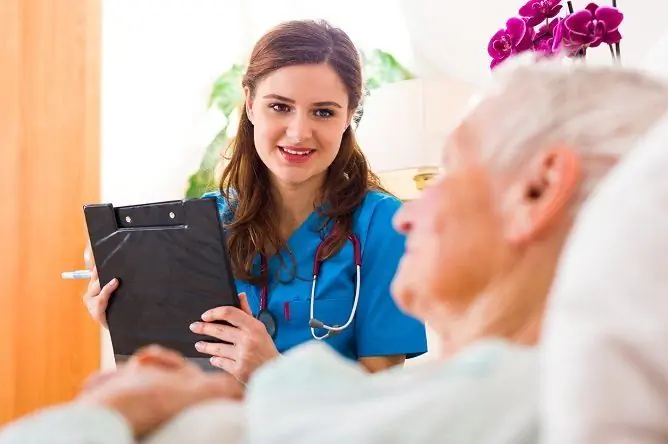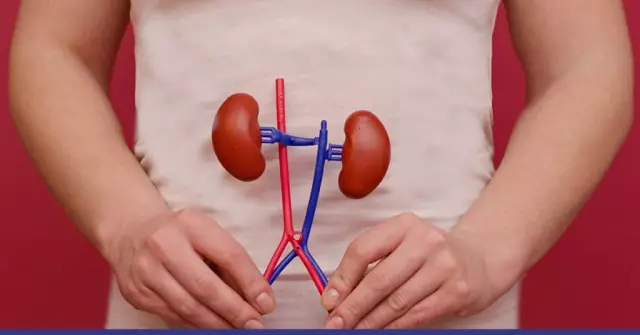- Author Rachel Wainwright [email protected].
- Public 2023-12-15 07:39.
- Last modified 2025-11-02 20:14.
Stroke: Rehabilitation After Stroke
The content of the article:
- Stages of a stroke and the beginning of rehabilitation
- Recovery of motor functions
- Restoration of vision and eye movements
- Recovery of speech
- Cognitive recovery
- Video
Rehabilitation after a stroke is an important step that is necessary to ensure the patient's recovery is as complete as possible. This is due to the fact that after a stroke, especially with severe brain damage, the ability to move, communicate, concentrate, remember and other vital functions is partially and sometimes completely lost.
How long does rehabilitation after a stroke last, how and where to take it, is rehabilitation possible at home? Answers to all these questions can only be given by the attending physician, who will take into account the degree of damage, dysfunction, concomitant diseases and other individual factors. However, based on the form of the stroke, the patient's age and physical condition, some conclusions can be drawn about the approximate duration of rehabilitation and which methods will be most effective.

Rehabilitation after a stroke begins as early as possible - immediately after stabilization of hemodynamic parameters
Before starting treatment and rehabilitation, it is necessary to obtain information about the quota for high-tech medical care in a rehabilitation clinic or sanatorium and, if possible, apply for it. According to reviews, in the treatment of patients who have received a quota, the latest methods and modern equipment are used, which allows you to get the best results. However, it should be borne in mind that this opportunity is usually denied to bedridden patients. Many clinics also accept patients under compulsory medical insurance.
Stages of a stroke and the beginning of rehabilitation
Depending on the type of stroke, rehabilitation after a stroke may take different time. Thus, rehabilitation after an ischemic stroke usually proceeds somewhat faster than after a hemorrhagic stroke, however, after a hemorrhagic stroke, dysfunctions are usually less extensive because of the more quickly provided assistance.
In the development of a stroke, several stages are distinguished, characterized by different changes in the functional structures of the brain:
- The most acute period is the first day after the attack.
- The acute period is from 24 hours to 3 weeks after a stroke.
- The subacute period is from 3 weeks to 3 months after a stroke.
After the end of the subacute stage of stroke, a period of convalescence begins, that is, recovery. This period is also divided into three main stages:
- Early recovery period (3-6 months from the onset of the disease).
- Late recovery period (6-12 months from the onset of the disease).
- The period of long-term consequences (more than 12 months).

In order for the patient to restore the ability to be in a stable upright position, a verticalizer is used
With a stroke, treatment and rehabilitation from a certain stage are carried out simultaneously, since rehabilitation measures begin in the acute period. They include early activation of lost motor and speech functions, prevention of complications associated with hypokinesia, provision of psychological assistance, assessment of the extent of the lesion, and preparation of a rehabilitation program.
Rehabilitation after an ischemic stroke usually begins 3-7 days after the onset of the disease, after a hemorrhagic stroke - after 14-21 days. The indication for the beginning of early rehabilitation measures is the stabilization of hemodynamic parameters.
Early rehabilitation treatment improves prognosis, prevents disability, and reduces the risk of relapse. The body more effectively mobilizes forces to combat secondary disorders (hypostatic pneumonia, deep vein thrombosis, the formation of contractures in the joints, the occurrence of pressure ulcers).
The main goals of post-stroke rehabilitation are further activation of the patient, development of motor function, restoration of movements in the extremities, overcoming synkinesis (friendly movements), overcoming increased muscle tone, reducing spasticity, training walking and gait, restoring vertical posture stability.
When a stroke has occurred, recovery from a stroke is carried out according to individual rehabilitation programs that the attending physician develops for each patient, taking into account the severity of the neurological deficit, the nature of the course and severity of the disease, the stage of rehabilitation, the patient's age, the state of the somatic sphere, the degree of complications, the state of emotional-volitional spheres, severity of impairment of cognitive functions.
Recovery of motor functions
The restoration of motor skills and motor functions is one of the main directions of rehabilitation. By the end of the acute period, most patients experience a weakening of motor activity of varying severity, up to complete cessation. If the patient has no general contraindications for early rehabilitation, prescribe selective massage, antispastic laying of the limbs, passive exercises.
Verticalisers are used to transfer patients to an upright position. These devices allow you to gradually accustom the body to being in an upright position after prolonged bed rest.
Patients with severe paresis of the lower extremity are taught to imitate walking in a lying or sitting position, then they can sit down and get out of bed on their own. The exercises get progressively harder. At first, the patient learns to stand with assistance, then on his own, then gradually switches to walking. First, the patient is taught to walk along the Swedish wall, then with the help of additional devices, and then without support. To improve the stability of the vertical posture, exercises for coordination of movements, balance therapy are used.

To restore the functions of the limbs, apparatus methods of rehabilitation are used
To restore movement in paralyzed limbs, electrical stimulation of the neuromuscular apparatus is shown, classes with an occupational therapist. The methods of physical rehabilitation developed for dysfunctions and lesions of the central nervous system (Bobath, PNF, Mulligan concepts) are widely used in combination with physiotherapy and massage. An effective method of restoring motor functions in paretic limbs is kinesiotherapy (exercise therapy), physical activity using specially designed simulators.
To restore fine motor skills of the hands, a special orthostatic apparatus with a manipulation table is used.
To achieve the best results in the fight against muscle spasticity and in hypertonicity of the upper extremities, an integrated approach is used, including the intake of muscle relaxants and the use of physiotherapeutic methods (cryotherapy, paraffin and ozokerite applications, whirlpool baths).
Restoration of vision and eye movements
If the lesion is located in the vessels supplying blood to the visual centers of the brain, a patient with a stroke may develop partial or complete loss of vision. Most often, after a stroke, presbyopia is observed - a person cannot make out fine print or small objects at close range.
The defeat of the occipital lobe of the cerebral cortex leads to a disorder of the oculomotor function on the side of the body opposite to the affected hemisphere. If the right hemisphere is affected, the person stops seeing what is on the left side of the visual field, and vice versa.
After a stroke, loss of certain areas of the visual field is often observed. In case of visual impairment, the patient needs qualified medical assistance from an ophthalmologist. Both medicinal and surgical treatment is possible. With minor lesions, therapeutic exercises for the eyes are used.

Speech recovery helps classes with a speech therapist
Restoration of eyelid functions is achieved with the help of complex gymnastic exercises for training the oculomotor muscles under the guidance of an ophthalmologist and physiotherapist. In some cases, surgery is required.
Recovery of speech
The greatest efficiency in the rehabilitation of patients with speech disorders can be achieved by individual lessons on the restoration of speech, reading and writing, which are conducted jointly by a neuropsychologist and a speech therapist. Speech recovery is a lengthy process that can take from several months to several years.
In the early stages of rehabilitation, stimulation techniques are used, they teach the understanding of situational phrases, individual words. The patient can be shown individual objects based on pictures, asked to repeat sounds, perform exercises on pronouncing individual words and phrases, then proceed to composing sentences, dialogues and monologues. For this, the patient tries to restore in memory the skills of the movable jaw and oral cavity.
In case of articulation disorders associated with a disorder of speech muscles, gymnastics of the muscles of the tongue, cheeks, lips, pharynx and pharynx, massage of the articulatory muscles are performed. Effective electrical muscle stimulation according to the VOKASTIM method using a special apparatus that develops the muscles of the pharynx and larynx.
Cognitive recovery
An important stage in post-stroke therapy is the rehabilitation of cognitive functions: restoration of memory, attention, and intellectual abilities. Dysfunctions of these functions largely determine the patient's quality of life after a stroke, they significantly worsen the prognosis, increase the risk of recurrent stroke, increase mortality, and increase the severity of functional disorders.
The cause of severe cognitive impairment and even dementia can be:
- massive hemorrhages and extensive cerebral infarctions;
- multiple heart attacks;
- single, relatively small heart attacks located in functionally significant areas of the brain.
Cognitive dysfunctions can occur at different stages of recovery, both immediately after a stroke and in a more distant period. Long-term cognitive impairment can be caused by a parallel neurodegenerative process, which is enhanced by increasing ischemia and tissue hypoxia.

Rehabilitation of cognitive functions is carried out with the participation of a neuropsychologist
More than half of patients who have suffered a stroke develop memory disorders in the first 3 months, but by the end of the first year of rehabilitation, the number of such patients decreases to 11-31%. Thus, the prognosis for memory recovery after a stroke can be called favorable. In patients over 60 years of age, the risk of memory impairment is significantly higher.
Memory recovery requires consistent sessions with a neuropsychologist and occupational therapist, as well as independent active work - performing special exercises for thinking, attention, memorization (solving crosswords and memorizing poetry). Often, patients after a stroke are additionally prescribed medications that stimulate higher nervous activity.
A prerequisite for the patient's independent life is the successful restoration of everyday skills, which will allow the patient to return home from the clinic or sanatorium, eliminate the need for the constant presence of a nurse or relatives, and also help the patient to quickly adapt and return to his usual life. The direction of rehabilitation, which adapts the patient to independent life and everyday activities, is called occupational therapy.
To restore cognitive functions after a stroke, drugs are used that correct cognitive, emotional-volitional and other mental disorders:
- metabolic agents (Piracetam, Cerebrolysin, choline alfoscerate, Actovegin);
- neuroprotective agents (Citicoline, Cerakson);
- drugs that affect neurotransmitter systems (Galantamine, Rivastigmine).
In addition to drug therapy, patients suffering from post-stroke memory and attention disorders are given psycho-correctional classes individually or in groups.
Video
We offer for viewing a video on the topic of the article.

Anna Kozlova Medical journalist About the author
Education: Rostov State Medical University, specialty "General Medicine".
Found a mistake in the text? Select it and press Ctrl + Enter.






